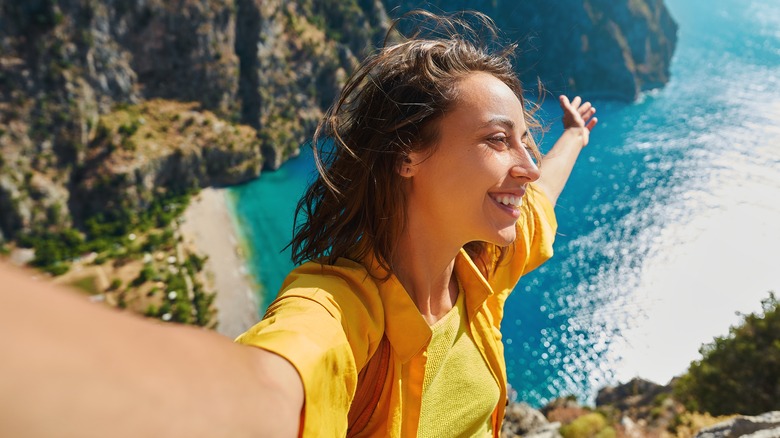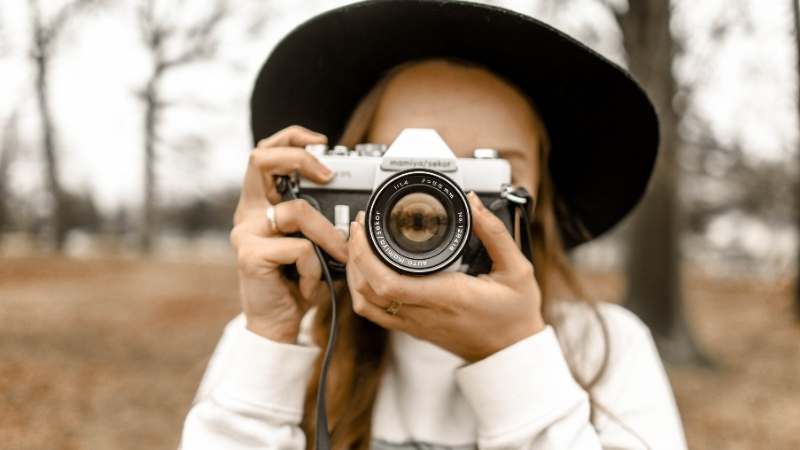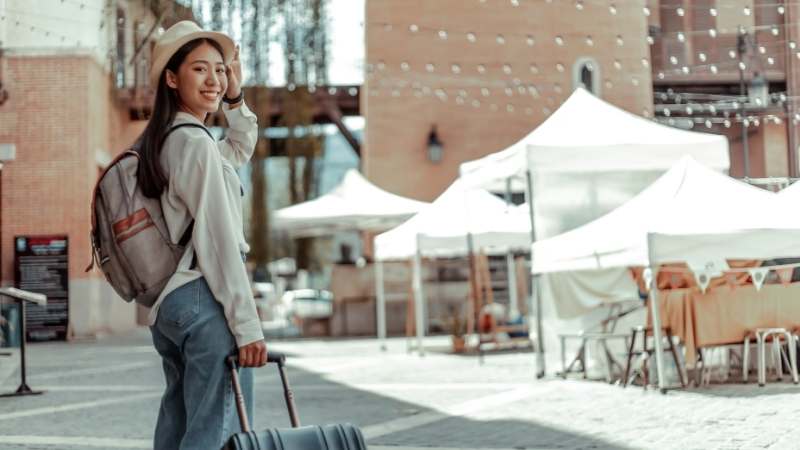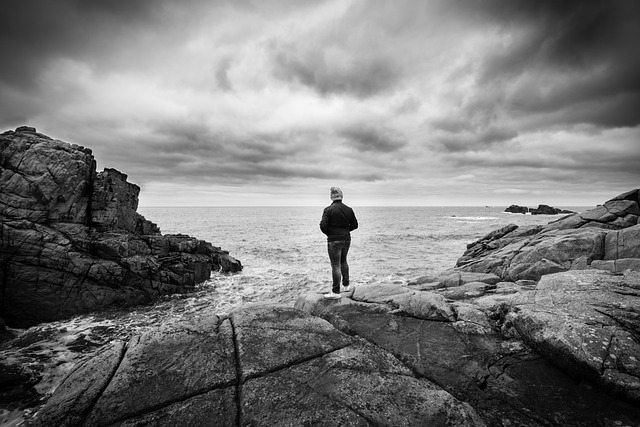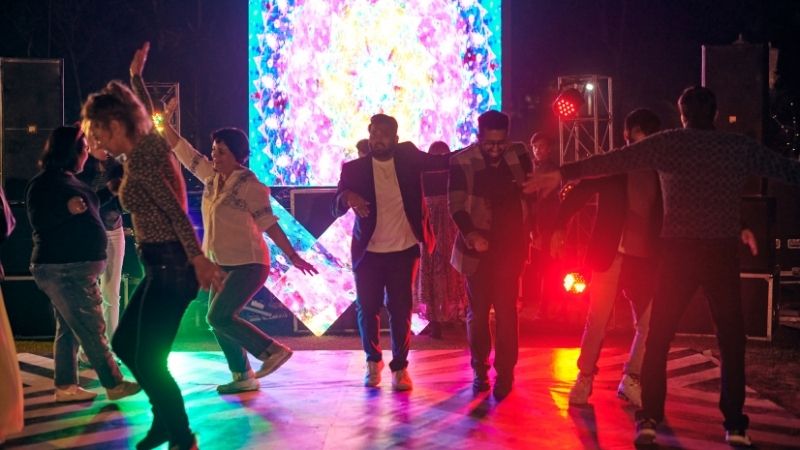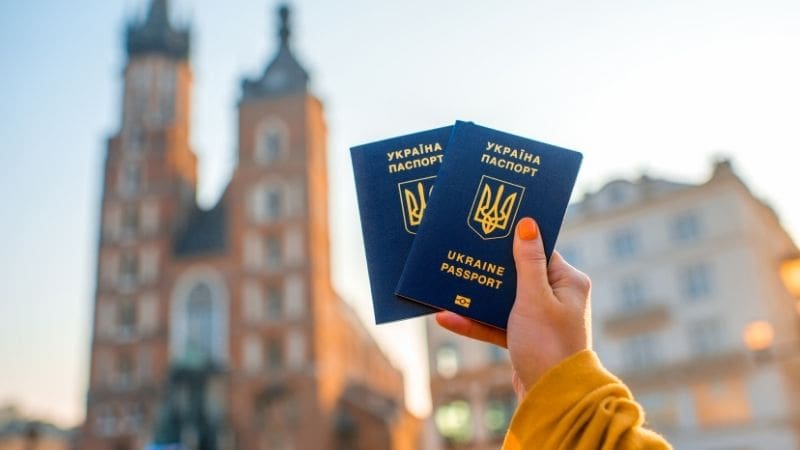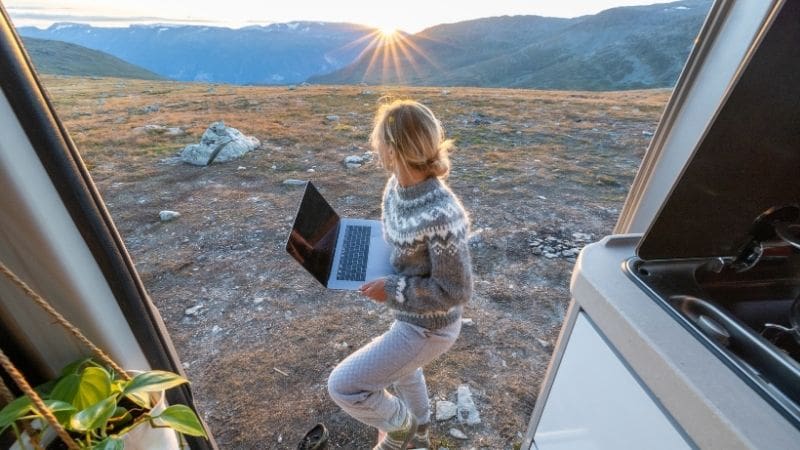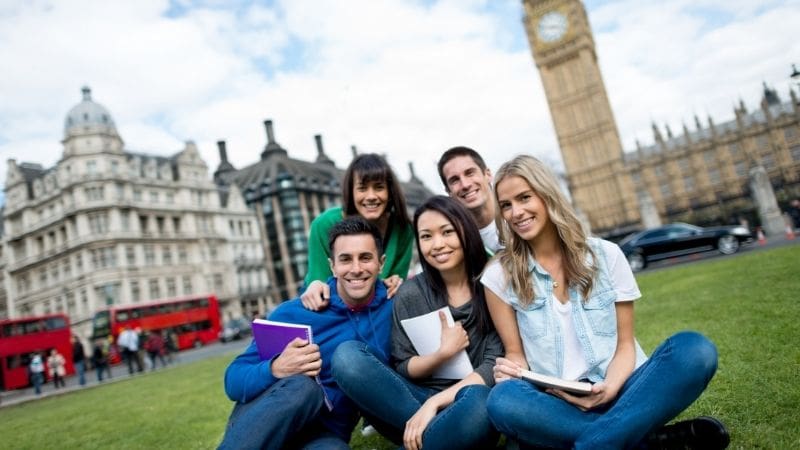23 Charming Things to Do in Switzerland in Winter

Crystal clear mountain lakes, snowy mountains, fresh air, the smell of melted cheese and mulled wine, picture postcard Winter scenes, and let’s not forget about the chocolate – lots of chocolate! Welcome to Switzerland in winter!
Cliche alert! Switzerland in winter is like a Christmas card. This has been written so many times, but it’s true! And I don’t mean one of those cards with a photo of Uncle Harold and Auntie Barbara in front of their Christmas tree with a glass of wine wishing everybody a Merry Christmas. No, I mean the ones with a drawing of a wintery village under a starry night, clusters of little houses with yellow lights in the small windows and puffs of smoke rising from the chimneys, and red mailboxes with a robin on top. You know the cards I’m talking about!
If you could jump into that Christmas card, that is exactly what Switzerland in winter is like. Ok, it’s not exactly – mailboxes are actually yellow in Switzerland. But you get the point! You can experience all this and much more. All you need to do is get on a plane and fly to this alpine paradise. Don’t go before reading this guide though, because it’s full of amazing tips from someone who’s lived in Switzerland for 8 years!
Psst: Planning a trip to Switzerland? Here are some other awesome posts to help you plan!

Travel tips for visiting Switzerland in Winter
Planning a trip to Switzerland in Winter? Check out these travel tips before you book your trip!
How cold does it get in Switzerland in Winter?
It’s hard to imagine looking at the snowy mountains, but Switzerland has a moderate climate. That means it generally doesn’t get excessively hot, cold or humid. That also means that there are exceptions: I’ve experienced -18ºC (3ºF) in the city of Geneva in Winter and 36ºC (100ºF) in Zurich in summer.
The average temperatures in Switzerland in summer range between 18 and 28°C (65° – 82°F) and -2 to 7°C (28° – 45°F) in Winter. In spring and autumn temperatures are somewhere between 8 to 15 °C (46° – 59° F).
Snow is almost always expected in the mountains of Switzerland, but the cities and towns at lower altitudes regularly get snowfall too in Winter!
More important is how quickly the weather can change in Switzerland, especially in the mountains. A sunny day could easily change into a thunderstorm. (Believe me, I’ve learned the hard way at least 10 times!) Try to pack for all weather conditions! Something to keep you cool, something to keep you warm (check out our cold weather packing guide) and something to keep you dry should work.
How do I get around Switzerland in Winter?
Switzerland is a small country, roughly the size of the state of Kentucky, that you can drive through it in about three hours. And luckily it has a public transport system that works incredibly well: it is efficient, always on time, and you can get to pretty much anywhere.
In Switzerland, you’re spoiled for choice. You can take a tram, bus, or train like in most countries, but this country adds a few more to choose from. Many boats, funiculars and cable cars are part of public transportation too!
Getting to a remote village in the mountains? Take the Postbus! (Guess what color it is?) This is an excellent service that runs coaches along old mail routes, which means they go anywhere.
Most of your journeys will probably be by train. Traveling by train is great in Switzerland! Not only does it get you from A to B, but it takes you through some of the most scenic landscapes in the world. For example, the famous Bernina Express goes from Chur or St. Moritz to Tirano in Italy, and the Glacier Express covers the cross-country stretch between Zermatt and St. Moritz, on which you can book the panoramic wagon, which has top-to-bottom roof windows that give you stunning views of the mountains you’re crossing.
The best thing you can do to get around is to buy a Swiss Travel Pass if you’re planning on doing a lot of public transport journeys within the country. You can buy a 3, 4, 8 or 15-day travel pass from CHF 232 (around US$ 254) to use on consecutive days. Want to choose your own days? The Swiss Travel Pass Flex lets you choose the days within a month. Prices start at CHF 267 (around US$ 292).
The pass gives you unlimited travel by bus, train or boat, including premium panoramic trains. It also includes mountain excursions to Rigi, Stanserhorn and Stoos plus discounts on other excursions, free admission to more than 500 museums and free unlimited use of local public transport in 90 towns and cities. Buying this pass is a no-brainer really, as it saves you lots of money traveling around Switzerland in winter.

What Apps Should I download for Switzerland?
Since Switzerland is such a small country with only 8.5 million residents, they actually have their own apps which makes getting around and planning easier!
Here are the Swiss apps that will help with general traveling:
- MeteoSwiss: This is a Switzerland-specific weather app that is far more useful than the normal weather app on your phone. You can search weather by area, and it will give information as to when precipitation is expected. I know that sounds like every other weather app but trust me, it’s more accurate and very useful for trying to see the elusive Matterhorn!
- SBB Mobile: if you use public transport, download the SBB Mobile app on your phone. This free app provided by the Swiss Federal Railways is the perfect transport planner. It knows your location and gives you real-time route planning.
- Google Maps: You will need this. Not only is it helpful for train times and platforms, but it will also help you find places mentioned in the itinerary and give you specific walking directions. It’s also good to have if you need to type in “food” at any point. Walking all day makes you hungry!
- Google Translate: Unless you are fluent in German, you will want to have this downloaded to translate words you don’t know. Though a lot of signage and menus are in English, that’s not always the case. You can even use the camera function to translate in real-time.
Do I need to speak the Swiss language?
There’s no such thing as the Swiss language. Switzerland has four official national languages: Swiss German, French, Italian and Romansh. The country is roughly divided in four linguistic areas. That means that there are towns and cities on the language borders that are bilingual. Either way, the Swiss are used to different languages. English is one of them. Overall, people speak a good level of English, so you shouldn’t have any problem getting by.
I think it’s always good to learn a few basic words and sentences, in case you need information and people don’t speak English. It’s also very much appreciated by locals. You don’t have to learn all four languages of Switzerland, but a bit of German and French will get you places!

Things to Do in Switzerland in Winter
Now you have everything you need to prepare for a trip to Switzerland, let’s inspire you with things to do in Switzerland in winter.
Go Skiing & Snowboarding in the Swiss Alps
How could skiing not be the first activity on this list? Switzerland boasts more than 350 ski resorts, from famous places like Davos Klosters to small single-ski lift local mountain slopes. If you’ve ever wanted to try skiing or snowboarding, Switzerland is the place to do it. Go for it!
Don’t worry about bringing your equipment. Ski rental places are very good and you can find them everywhere.
If you’re an absolute beginner, it’s best to find a ski resort with beginner’s slopes. Those are the resorts that will provide lessons as well if you need them.
Most resorts have a live webcam on their website, so you can always check the weather conditions before you go!
If you’re looking for the full Swiss skiing experience, here are some of the best places to ski in Switzerland:
- Zermatt – Home of the famed Matterhorn, Zermatt is known for having the best snow, due to its microclimate. The glaciers allow for longer ski seasons too. They also have great bars for après-ski and booming bars in this touristy town (or just go straight here if you don’t like skiing!).
- Flims/Laax – This place is vast! This is where I saw horizontal ski lifts for the first time, just to get you from A to B. Flims/Laax is great for beginners, as there are lots of easy blue slopes. It’s close to Zurich too, which makes it easy to go for the day!
- Davos – This is the highest city in Europe at 5118 ft with stunning ski slopes and routes (so give yourself an adjustment period in Switzerland before heading straight there). Head to Pischa Freeride Mountain for some quality powder snow. Snow is saved from last year and sprayed on this slope. Pretty clever stuff! All the pow-pow without the risk of avalanches!

Race down a mountain on a sled
If skiing is really not your thing, there are lots of other ways to have fun going down a slope. Sledding is so exhilarating! You can do it in many ski resorts, but the car-free town of Braunwald in the canton of Glarus, in the east of Switzerland, is a local gem and my favorite! It takes just over an hour to drive there from Zurich, add another hour if you go by train.
Here the toboggan slope is completely separated from the ski slopes and even has its own cable car. Rent a wooden sled, get in the cable car, then get ready to race down to the bottom of the track. Sit down, legs on the side for braking and steering and off you go! The 1.5-mile snow track has ups, downs, exciting turns and stunning scenery. It’s like go-karting on snow (Yes, it’s THAT fast!). Ear-to-ear smiles guaranteed!
Do you know what’s even better than sledding down a mountain? Sledding down a mountain at night! In Braunwald they light up the sled track between 7 and 10pm. It’s magic!
You can even book a sledding tour in central Switzerland in Interlaken that comes with a cheese fondue dinner. There are so many opportunities to feel like a kid again!

Get all Christmassy at a Christmas Market
A mug of hot mulled wine, choirs singing Christmas carols, the smell of roasted chestnuts, raclette and cinnamon, snowflakes falling…the Christmas markets are something you must experience in Switzerland in December.
I really enjoy the Christmas market in Zurich. Bahnhofstrasse, the main shopping street is completely lit up with lights that look like shimmering stars in the night sky. On the adjacent squares, you’ll find lots of stalls with Christmas decorations, mulled wine and street food. There’s a singing Christmas tree, which is a triangular stage in the shape of a tree, where choirs stand on different levels and sing Christmas carols. This market usually starts a month before Christmas and closes just before Christmas.
Some of the best Christmas markets in Switzerland:
- Basel – This market was voted the most beautiful Christmas market in Europe. You can find it on Barfüsserplatz and Münsterplatz, which is right in the heart of the festively decorated Old Town, and it is one of the largest Christmas markets in the country.
- Zurich – Christkindlimarkt is inside the main station and around Bahnhofstrasse, and is a bit cozier than being outside! It’s famous for the Singing Christmas Tree, a stage on multiple levels in the shape of a Christmas Tree, on which choirs perform.
- Gruyères – This Christmas market is famous for the Christmas decorations made by artisans. The Christmas market in Gruyères normally only takes place two weekends in December, so check the website for this year’s dates.
- Lucerne – The Christmas market in Lucerne is normally on from December 1st until Christmas. It takes place in the Old Town, away from the bustle of the main shopping street. There is an enormous advent wreath each year that’s built around the Franziskaner fountain!
- Montreux – I like the Christmas market in Montreux because it’s lakeside. You can meet the real Santa Claus in his residence on top of Roches-de-Nayer at 6,500 ft (it must be the other one who lives at the North Pole). From the Christmas market, you can see him flying through the sky on his sleigh though. Magic!

Sleep in an Igloo
Ok, so you like snow, you like cold, you like to go to Switzerland in winter. But would you sleep in an igloo? It’s what I asked myself a few years ago, and somehow my partner must have read my mind. Shortly after it was my birthday and guess what I got?
A few hours later, around sunset, I’m walking up a mountain, following a dude who works for Iglu-dorf (Igloo village). Looking behind me I see the cable car station and restaurant disappear, together with the rest of civilization. We reach a building made out of ice. It’s like a hotel. There’s a bar, a restaurant and a corridor with a few rooms. They’re all made of ice!
Iglu-dorf is pretty cool (no pun intended). They serve a warming cheese fondue, mulled wine and other hot drinks. It keeps you warm! There’s a sauna as well, and a hot tub. A magical experience, to be outside in a hot bath in the mountains in the dark, under the stars.
I stayed in Davos in the east of the country, but there is an Iglu-dorf in Zermatt and Gstaad as well.
Did I have a good night’s sleep? F*ck no! The bed is literally a block of ice with a shammy on top and a pile of woolen blankets. Was it an unforgettable experience I still think about every now and then, years after? Hell yeah!

Pamper Yourself at a Spa
Is just reading about racing down mountain slopes way too much excitement? Maybe a spa day is more your thing (who doesn’t like spas, right?). There’s nothing like sitting in a hot thermal bath, outside, while snowflakes gently land on your zen head.
Switzerland does a spa day right! Most spas are like public swimming pools. No need to book anything, unless you’d like any treatments. You just show up, pay the entrance fee and for a few hours you have access to thermal indoor and outdoor pools, fire and ice baths, steam rooms, saunas, hot tubs, drip caves and relaxation rooms. Towels are provided.
Going to a spa is all about recharging, so keep in mind to speak quietly and let other people relax (so ignore those thoughts of cannonballing in that thermal water!). If you’re planning on going to the sauna, please note that you are required to be naked. (It’s not like you know anyone in there, like your boss, but that’s another story).
If you’re looking for an amazing spa day in Switzerland, I can recommend one of these spas (or just go to all of them!):
- Grand Resort Bad Ragaz – Bad Ragaz is a picturesque town in the canton of St. Gallen, in the east of the country. It’s full of quirky art too, like an open-air museum. The thermal bath gets its healing water from the Tamina Gorge nearby. The spa offers full treatments, thermal baths, saunas and aromatherapy steam rooms.
- Sole Uno in Rheinfelden – In the north of the country, on the border with Germany, you’ll find the Sole Uno spa. Thermal baths, saunas with outdoor relaxing gardens, fire and ice baths, aromatherapy steam rooms and -check this out- there is a cave in the basement with a very salty pool to float in. Stick your ears underwater and you’ll hear relaxing music!
- Hürlimannbad & Spa Zurich – Bathing and relaxing in centuries-old vaults, but in the middle of the city? This thermal bath and spa is in Zurich and offers splendid views of the city, from its outdoor thermal pool on the roof. Their Roman-Irish spa ritual is unique in Switzerland!

Grab a Bag of Heissi Marroni
Switzerland is not famous for street food, but the smell of heissi marroni (roasted chestnuts) takes me right back. It starts in October, when the smell of roasted chestnuts fills the air. Go for a wintery walk in a town or city, like Zurich or Geneva, and you will find wooden stalls roasting chestnuts and selling them. Buy a bag of freshly roasted hot chestnuts. They taste great, are warming and give you enough energy to keep walking.
Eat them slowly – first of all because they’re hot – but holding the bag with chestnuts is also a great way to warm your hands!
The chestnuts are sourced south of the Alps, in the Italian-speaking canton of Ticino. According to local belief, the first chestnut you find brings good luck, as long as it’s carried in your left pocket. I tried it. It was uncomfortable. No luck for me!
The best nuts in Switzerland? Ask anyone and you will get a different answer. I find most of the stalls very good, but the chestnuts by the Zytglogge – the famous clock tower in Bern – stood out!
Feast on a Swiss Fondue
Speaking of nice-smelling foods in Switzerland in winter, a fondue can’t be missed from this list. It’s the ultimate winter-warming-cozy-in-a-Swiss-chalet food you can find in Switzerland. Fondue is melted cheese and wine in a hotpot on a portable stove. The pot sits in the middle of the table. You eat the cheese by dipping pieces of bread in the pot using long, thin forks.
Now, you can eat fondue everywhere in Switzerland, but the quality differs. It all depends on the Swiss cheese that’s being used. Ask any Swiss person what their favorite kind of fondue is, and they would probably say moitié-moitié (yep, that means half-half). Moitié-moitié has equal amounts of Gruyère and Vacheron Fribourgeois cheese. It also contains potato starch, white wine, black pepper and cherry schnapps.
If you’re in Zurich, try a fondue at Chäsalp. This former farm-turned-chalet is a rustic restaurant where you can try all kinds of fondue, including moitié-moitié. In Lucerne, try the Fondue House Du Pont, which overlooks the River Reuss and the Jesuit church.

Have More Melted Cheese! Raclette!
I hope you like melted cheese, because there’s another dish you should try in Switzerland in winter. Raclette! A large round of Swiss cheese is placed next to a wood fire until it slowly starts to melt and drip. The cheese is then scraped off and served on a plate with boiled potatoes, dill pickles, pickled onions and various slices of cured meat. Traditionally it’s served with a cup of black tea, to help with digestion, but nowadays it’s often served with wine (definitely choose the wine!)
A more modern kind of raclette you see in restaurants is to have an electric grill on the table. The cheese is sliced and put in a tiny frying pan, which is placed under the grill. The principle is the same as the traditional way, but this is more sociable. A raclette meal with a group of people can last hours!
I recommend Le Chalet, which is part of Hotel de Gruyères, in Gruyères. It’s a chalet-style restaurant that’s cozy and warm in Winter!

Be like Charlie and Visit a Chocolate Factory
Unleash your inner Willy Wonka and see what it’s like to be in a real chocolate factory. Swiss chocolate is world-famous and for good reason. The average Swiss person eats 22 lbs. of chocolate per year!
The most famous Swiss chocolate brand is Lindt & Sprüngli, and you can visit their factory museum in Zurich. If you’re in Geneva, I recommend going to the Favarger chocolate factory. This is the only Swiss chocolate manufacturer that still follows the whole process of chocolate-making, from raw cocoa beans to chocolate bars.
The Favarger Experience is a very interesting and fun activity. It starts with a tour in the museum, where you learn everything about the history of Favarger chocolate and the chocolate-making process. The tour is great, but the chocolate tasting is greater! You get to taste the different flavors they make here. Then you even get to make your own chocolate to take home (mine didn’t make it outside the door though!).
Get Smacked by Schmützli
How about getting smacked with a bunch of sticks by a scruffy-looking person in a robe while you’re strolling through the city? (Hey, you are the one who wanted to experience Switzerland in winter!) The Swiss version of Santa is called Samichlaus – in other European countries known as St. Nicholas. He’s the patron saint of children and on December 5th he arrives with his donkey, from his mountain cottage. He brings the children who come to greet him candy, chocolate, clementines and ginger biscuits. Lovely guy!
His helper, not so lovely! He’s called Schmützli, which means dirty in Swiss German. Brown robe, scruffy black hair, smudged face, carries a brown sack and a bunch of sticks. Pretty creepy-looking guy if you ask me.
Long story short: he robbed three children once, killing them in the process. St. Nicholas brought them back to life and punished Schmützli by making him his helper. So now he keeps calm and hands out candy (every cloud has a silver lining I guess). Just keep an eye on him, he might still smack people every now and then.
Want to see Samichlaus and Schmützli? The annual parade in Zurich takes place at the end of November around Bahnhofstrasse. The parade follows a specially decorated tram. The children read poems and sing songs, in the hope of receiving a gift or candy. It’s very Christmassy, but not as you know it.
The event in Zurich is by far the biggest Samichlaus parade, but most cities and towns have their own Samichlaus festivities. In Küssnacht you can attend Klausjagen (St. Nicholas Chase) which is a procession in six stages that involves whip cracking, firecrackers, noisy bells, enormous miters, Samichlaus and four Smützlis.
There’s also a Samichlaus Swim in the Limmat River in Zurich in December (yes, as in freezing-cold-water-December). Nothing to do with Samichlaus, but it’s around the same time. You can even meet Samichlaus and Schmützli in a forest hut in some places (yeah, I’m gonna say no to that too. Have you ever watched the Blair Witch Project?).

Go on a Snowshoe Walk
The mountains of Switzerland are not all about skiing, snowboarding and sledding. Let’s not forget that the Swiss Alps are stunning nature reserves that beg to be explored on foot. There is an abundance of hiking trails with various difficulty levels. Whether you want to do a quick 1-mile loop or a full-day hike up to a mountain top, it is definitely something to try!
At the ski rental places, you can also rent snowshoes, which are a must when you walk through deep snow. When put on snowshoes, you have more grip in the snow and it also stops you from sinking in the snow.
Enjoy the wildlife and bring a picnic. There are more scenic picnic places than you can bring sandwiches!
Would you like to have a go at snowshoeing? Here are some of the best routes:
- Sellamat – This is a great trail for beginners in the east of Switzerland, in Toggenburg, near the border of Liechtenstein. The Sellamat Snowshoe Trail is a moderate – but with some steep climbs – three-mile walk that takes about an hour and a half to complete. The loop starts at the Sellamat ski lift and there’s a mountain restaurant there too.
- Engelberg – Engelberg is one of my favorite places in Switzerland in Summer, but for snowshoeing it doesn’t disappoint either. Take a train from nearby Lucerne, then take the cable car up to Engelberg. The Obertrübsee Trail is a 4-mile wide loop around Trübsee, a frozen lake. I found the loop on the easy side of intermediate. On a clear day, it gives you some spectacular views of Titlis (I’m not being rude: it’s the name of a mountain).
- Muottas Muragl – This is a snowshoe route I’ll never forget. It’s in the Engadin, an incredible valley in the Eastern Alps. Start going up the Muottas Muragl cable car. The moment you’re at the top, you’ll be spoiled with impressive views of the Silvaplana Valley and the Bernina Alps. The mountain peaks seem to be very close by. The walk is only 2 miles long, but the views keep getting better. Back at the mountain station, enjoy an ever-changing sunset over dinner in the panoramic restaurant.

Practice Your Pirouettes on Ice
Switzerland in winter gets cold enough for some lakes to freeze over. When that happens, you know you need to go ice skating! Skating on a frozen lake is somehow more exciting than on an ice rink, and the surroundings are beautiful. I love ice skating in Sils!
Don’t worry about packing your ice skates (Does anyone do that, apart from Olympic ice skaters?), because you can rent a pair right there. There will be stalls that sell food and hot chocolate as well – hot Swiss chocolate that is!
Where to go ice-skating on a frozen lake? These are great options:
- Lac de Joux – Go big or go home! This lake in the canton of Vaud, in the west of Switzerland, is huge. It completely freezes over, so you can really do some long-distance ice skating. Mind the ice sailers though!
- Skateline Albula – Now this is something special in East-Switzerland. Normally you skate on an ice rink or frozen lake, but this is like ice skating on a hiking trail. Whizz through snowy forests, on a natural ice track, on ice skates!
- Alp Raguta – If you’re so good at ice skating you don’t have to look at your feet all the time, try the natural ice rink with the best alpine views. Is it still a view when you’re right in the middle of it? The backdrop is just mountains all around.

Admire the Swiss landscape from a train window
Train journeys in Switzerland are always a great experience, no matter where you go. The most famous train routes are the Bernina Express and Glacier Express. These world-famous cross-country journeys take you through alpine meadows, luxury ski resorts, right along the shores of big blue lakes, majestic mountain passes, small towns and bigger cities.
The Glacier Express goes from Zermatt to St. Moritz. Don’t be fooled by the short distance of 180 miles, because this train journey takes 7 hours! The Bernina Express covers only 76 miles from Chur via St. Moritz to Tirano in Italy, but it takes 4 hours! You don’t have to book the whole route. There are many stations en route, so you can choose to travel part of the journey.
The best thing about the trains is that you can book premium panoramic tickets. These railcars have top-to-bottom panoramic windows. It’s like riding a roofless train, but without getting your face frozen!
Spot Celebrities in St. Moritz
I’ve dropped the name St. Moritz a few times now, so it’s about time it gets featured. This is a town you want to visit when you’re in Switzerland in winter! It’s in the Engadin Valley in East Switzerland and it all seems to happen here in this luxury alpine ski resort. Think fancy restaurants, 5-star hotels, celebrities on holidays, and you being there!
Even though St.Moritz isn’t officially a city, it does feel like one. It has a frozen lake, which is the center stage of polo, cricket and horse-racing events on ice! St. Mortiz hosted the Winter Olympics twice, so sports play an important role in this town. It boasts several ski and snowboard areas, the Cresta run, a natural ice-bobsled run, and lots of langlauf (cross-country skiing) trails.
Go people-spotting and you’ll notice a lot of fashionable outfits, expensive supercars and maybe even a celebrity! It all seems very out of place in a sport-happy mountain resort, but somehow St. Moritz makes it work. And it does it in style!
St. Moritz is the epitome of Swiss Winter holidays. At the same time, it gets around 322 days of sunshine a year! It has everything you need if you’re after skiing (in Corviglia, Corvatsch, or Diavolezza), great food (try Banfi’s Bar-Restaurant for Swiss cuisine, Restaurant Cresta Run for pizzas and Restaurant Engiadina for Italian and Swiss dishes) and spa days (I recommend Ovaverva) in a chic, cosmopolitan ambiance. Visiting this ski resort is an experience in itself!
St. Moritz is in the Upper Engadine Valley, at 6,089 ft above sea level. You can easily reach St. Moritz by car or by train from Zurich Airport. The train journey takes a bit less than 4 hours, but it’s a stunning route.
Cool things to do in St. Moritz in Winter:
- Olympia Bob Run – This is the largest ice sculpture in the world! A natural ice bob run that’s more than a mile long and runs from St. Moritz to Celerina. The best thing? You can go on it! In a bobsled! With people who know what they’re doing!
- Snow Yoga – There are lots of different types of yoga, but have you ever tried snow yoga? It’s completely zen to do a downward frozen dog at 8,200 ft, just a bit colder than normal! This is a very cool experience (pun kind of intended)!
- Horse-racing – If you’re in St. Moritz in February, you’re in luck! That’s when the annual White Turf horse race takes place on the frozen lake. This is an enormous event that draws in 30,000 spectators. The thrill of watching the horses thunder along the ice is incredible!
See the Matterhorn from Zermatt
Speaking of famous mountain resorts, Zermatt is probably one of the most famous Switzerland in winter destinations. The town is 5,249 ft above sea level and is completely car-free, which makes it a brilliant place to explore on foot. It’s a paradise for skiing and hiking, but if that’s not your thing there are lots of restaurants and boutique shops to discover. Zermatt is well-known for its views of the famous Matterhorn Peak. Check that box of Toblerone in your cupboard, it’s THAT mountain! Now eat chocolate!
From Zermatt, you can easily take excursions to three mountain tops: Gornergrat, Rothorn and Matterhorn Glacier Paradise. Take a funicular and cable car to Rothorn for stunning views of the Matterhorn. To reach Gornergrat, you have to take the Gornergratbahn, which was the first electric cogwheel railroad.
Matterhorn Glacier Paradise is stunning. From the highest viewpoint in Europe (12,739 ft) you have a 360º view of 38 13,000 ft mountain peaks and 14 glaciers! There’s also a glacial palace you can go into.
More about Zermatt, the Matterhorn, and Matterhorn Glacier Paradise in our article 23 awesome things to do in Zermatt!
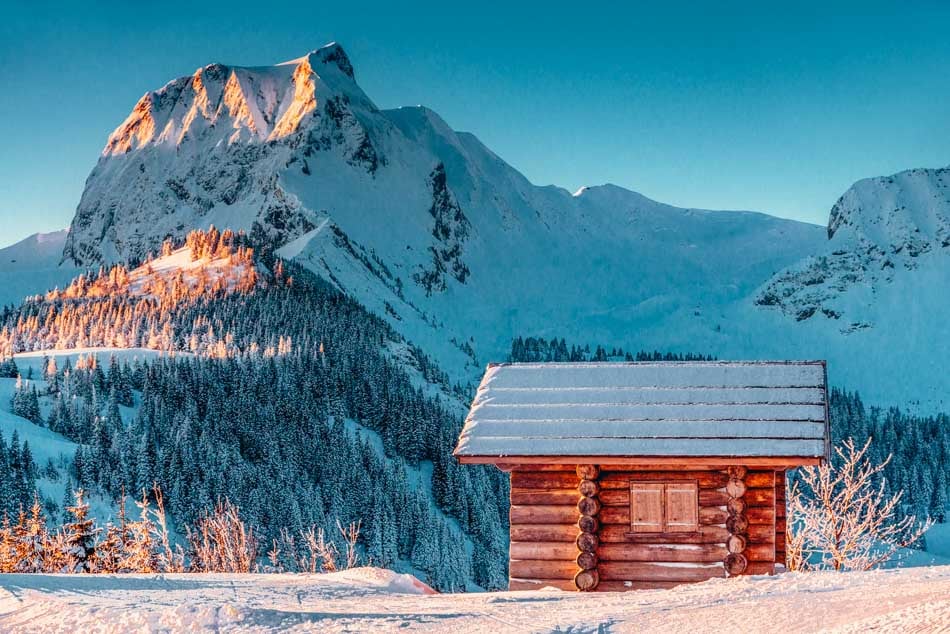
Stay in an alpine chalet
Accommodation in Switzerland – the land of the hospitality industry – is of a high standard, whether you stay in a luxury hotel or a simple B&B. For a more authentic experience, stay in a wooden chalet. They are just made for Winter!
Chalets are very well equipped for a Winter break. They are a well-deserved reward after a day in the snow. There’s nothing like coming home to a wooden chalet when you’re cold and tired, just to have a hot bath and sit by the fire, looking out the window with a glass of wine, taking in the mountain views.
Chalets are often great accommodation for groups, but here are some cozy smaller options:
- Chalet Gädi – This small chalet on a hill overlooking Zermatt is the ultimate chalet experience. Sit on the balcony with perfect views of the Matterhorn, and though you feel “in the mountains”, the town center is only about half a mile away. Watch the lights of the village come to life at night and cozy up in this perfect chalet.
- Chalet Aphrodite Ost – Grindelwald is a great place for a winter stay in Switzerland, as it’s close to so many other adorable Swiss villages in the Alps, including the lovely Lauterbrunnen. This chalet has everything you need to relax after a day in the snow, including stunning views of the mountains.
- Sunnehuesli – This simple wooden chalet is quiet and very close to the ski slopes in Braunwald. This car-free town in the east of Switzerland has great ski slopes, a sled track, and lots of walking routes.

Visit the Olympic Museum in Lausanne
If you like sports, the Olympic Museum is a must-visit. You can find it in Lausanne, a beautiful city on the northern shore of Lake Geneva. For more than 100 years, Lausanne has been the home of the International Olympic Committee. There is no better place for this museum than Lausanne!
Even if sports are not your thing, I would still recommend this museum. It has interesting artifacts such as equipment, medals and outfits worn by famous athletes and shows the history and development of sports and Olympic athletes alike. The exhibits are fun, with interactive games and experiences throughout the museum. There’s a running track outside, where you can race against a series of lights that represent Usain Bolt’s speed. Can you beat him?
You can easily spend a morning here! Don’t forget to explore Lausanne as well. The city has a unique vibe and offers a great mix of French and Swiss flair.
If you have more time here, visit nearby Vevey and Montreux, where Freddie Mercury used to live. The Unesco World Heritage vineyards of Lavaux are also close by and worth visiting (and some wine tasting!)

Visit Mediterranean Switzerland
Have you ever looked at a map? I know it sounds like I’m mixing up my countries here, but yes, Switzerland -the alpine country- actually has a Mediterranean part in the south. It’s the canton of Ticino!
People speak Italian in Ticino, the landscape looks Italian, the food is Italian, even the weather is Italian. It’s just much more organized than Italy (sorry Italy, I love you really!) This unique mix of Italian dolce vita and Swiss efficiency makes Ticino a wonderful place to be. Especially in Winter, if you don’t like snow and cold that much. Winter here is much milder than in the rest of Switzerland, but it does snow sometimes. The mountains in the north of Ticino are covered in snow in Winter.
Cities to visit in Ticino are Lugano for its metropolitan lakeside vibe, Locarno for exploring the old town, full of alleys that lead to a central square, Ascona for its lakeside promenade with bars and restaurants, and Bellinzona for its three medieval castles.
Want to be immersed in overwhelming nature? Visit Valle Verzasca, a valley burrowed in a spectacular mountain landscape. A blue river runs through it. It’s perfect for hiking, mountain biking, or just relaxing. Just don’t even think of swimming in the river in Winter! (Even in Summer it’s f*cking cold!)
Go Dog Sledding in the Alps
Always wanted to go sledding with huskies? But never wanted to go to the North Pole? I can totally relate! You don’t need to travel to the Arctic Circle to go dog sledding. Just do it in Switzerland, in the Alps!
The panoramic dogsledding tour by Takitrek in Verbier in southwest Switzerland is a lovely experience. You get to meet and greet the dogs that will pull your sled. The tour takes you through stunning wintery landscapes, which are even more beautiful on a sunny day. On the 3-mile route, you’ll learn everything about the daily life of the dogs and their musher (yep, that’s the person controlling the dogs. I learn something new every day!)
The experience is very relaxing. You’re outdoors, breathing in the cold fresh air, silently whizzing through the snowy pine forests. There’s nothing else like it!
Have you ever dreamt of being a musher (or at least, since I told you what it means)? Book the half-day discovery tour, which is longer than the panoramic tour. On this tour you’ll learn how to drive the sled, and after that, you can have a go at controlling the dogs and steering the sled. So mush fun! *Ba dum tss!*
Dive in an Icy Lake
Yes, you read that right! Ice diving is a thing. It’s like scuba diving in clear water with tropical fish, but without the tropical fish. Without anything tropical really. You have the same diving gear, but you lower yourself through a hole in the ice. Are you still reading? Might be something for you then!
The setting is Lake Lioson, a frozen lake between Gstaad and Aigle in the southwest of Switzerland, where you’ll find snowy mountains and snow-covered ice on the lake. This white landscape is absolutely stunning. Perfect place to go scuba diving, said no one ever!
But when you actually dive underneath the ice, you’ll witness a special play of light, reflections, bubbles and the occasional fish that makes you forget the cold (it’s actually so cold that you’ll never f*cking forget this, ever, but you get the point).
Luckily the nearby Restaurant du Lac Lioson is nice and warm and serves a well-deserved fondue, so you can get warm and think about this cooler-than-cool adventure.
Heat Up in a Sauna & Dip in a Frozen Lake
Let’s swim in equally ice-cold water, but heat ourselves up in a sauna first, so you get even more of a temperature shock! In theory, this sounds awful, but I personally think this is much nicer than ice diving. The sauna gets you so hot and sweaty, that you want to cool down. Ice cold water or not!
A great place to experience a nature sauna is at the lido in Buochs. A caravan is converted into a sauna and placed right next to Lake Lucerne. You can book this private sauna just for yourself, to give your body a boost that makes you feel relaxed at the same time. The instructions are easy. Heat up in the sauna until you get really hot, jump in the lake until you get really cold, repeat.

Find Your Inner Cave Person in Vallorbe
Vallorbe is a small town in the Swiss Jura mountains, along the banks of the River Orbe. It’s famous for the Vallorbe Caves, a cave system that was formed when the sea that covered the Jura retreated. This was 7 million years ago! Now the caves are open to the public and one of the best you can find in Europe.
The Vallorbe Caves are worth a visit! Like most caves, you’ll find impressively shaped stalagmites and stalactites, cavernous halls (see what I did there?), siphons and an underground river. The river is wild and noisy at times, and sometimes nothing more than a quiet trickle.
Four chambers cut into the caves are home to the ‘Fairy Treasure’, a collection of 250 rare, stunning minerals from all over the world.
Get Your Yodelayheehoo On!
Yodeling is the sound of the Alps. Shepherds used it as a way of communicating with their herd or with other shepherds between villages. Different calls mean different things. Nowadays it’s part of cultural folklore and in Switzerland, you’ll still find performers yodeling songs at local events.
In the small canton of Appenzell, yodeling is still practiced regularly. Here you can hear an eerie kind of yodeling on New Year’s Eve and again on January 13th (New Year’s Eve in the Julian calendar). The sounds are slow and haunting. They come from mummers, men dressed in pagan costumes with masks and an enormous cowbell around their necks. Hauntingly yodeling they roam the streets in the early hours, knocking on doors to wish people a happy new year.
Want to learn how to yodel and let your voice carry over long distances through the mountains? Try a yodelling lesson in Appenzell! Before you know it, you’ll be yodeling your messages from a mountaintop. Let’s be honest, it sounds a lot better than shouting: Mum, what time is dinner ready?
Visit Jungfraujoch, Top of Europe
Time to take things higher up again! Is the Top of Europe high enough for you? Take the train to the highest train station in Europe. Welcome to Jungfraujoch! Located at 11,630 ft above sea level, it’s high enough to make you feel dizzy when you get off the train. (Not that that happened to me or anything…let’s move on.)
The trip to the top is quite long, but absolutely worth it. Plus, the actual journey is part of the experience. Imagine the engineering it took to get a train route and station at that altitude!
It takes about an hour and 45 minutes to get to Jungfraujoch from Lauterbrunnen, and you will have to start at Lauterbrunnen railway station and take the train to Kleine Scheidegg (sit on the right side for the best views of the Alps, though a lot of the ride is through a tunnel). Your Swiss Travel Pass covers your fare to Wengen (the stop before Kleine Scheidegg), but past that you will get a 25% discount on the rest of the journey including to Jungfraujoch. Once at Kleine Scheidegg, you’ll hop on the Jungfraujoch train that is going to take you to the top!
Give yourself at least 4 hours to explore Jungfraujoch once you arrive, as there is plenty to do at the top from movies to kitschy displays to an ice palace to hiking the majestic Alps! There are plenty of restaurants and shops as well, so you won’t go hungry and you can easily spend more money. Take the elevator up to the main viewing platform, called the Sphinx Terrance, for exceptional views of the Alps and the Aletsch Glacier.
You can explore all the different ways to get to Jungraujoch here, and Lauterbrunnen is a great destination on its own – Here are 23 lovely things to do in Lauterbrunnen!
What to Pack for Switzerland in Winter
Here are our recommendations for clothing that’s travel-friendly, functional AND super cute to wear in the winter. If you’re looking for more details, we’ve got a full Europe in winter packing list guide.
- Warm Walking Boots: Do not skimp on your shoes for your trip to Prague in the winter! This is a walking city and it will be COLD, so you need to have shoes that are up to the task. We recommend boots that can withstand ice or snow, are totally waterproof, and are comfortable enough to walk in for HOURS, especially on uneven cobblestone. Our favorite winter boots are cute, insanely comfortable, waterproof and thermal lined to keep your toes toasty warm, and extremely lightweight and foldable so you can stuff them in your bag when you travel. Plus, they have thin and flexible soles that let your feet function as if you were walking around in freezing cold Prague completely barefoot! Note: you might find yourself in need of some calf strengthening before your trip if you’re not used to barefoot-style soles. Here are my boots and Jeremy’s boots. You can read more about them in our round-up of our favorite travel shoes for women or for men.
- Wool Socks: Run-of-the-mill acrylic or cotton socks won’t keep your feet warm while you’re out exploring on a cold day. Make sure you get socks with wool blended in to keep your toast toasty warm and insulated, like these or these.
- Warm Coat: Like good warm shoes, a warm winter coat is absolutely necessary. .I brought 2 jackets with me to Europe: a beautiful camel-colored A-line wool coat like this one that kept me incredibly warm and looked amazing in all of my pictures, and a travel-friendly packable down jacket that I kept stuffed in my daypack in case I needed an extra layer! Jeremy wore a wool-blend coat similar to this one and this one.
- Travel Jeans: Unlike regular jeans, travel jeans are designed specifically to solve travel-related woes. One of my personal woes is the lack of pockets on women’s jeans. My favorite travel jeans have 6 POCKETS. 6!! And 2 of them are zipped and hidden inside other pockets, for extra pickpocket protection – crucial in any European country. Jeremy and I each have a pair of Aviator USA black jeans. They’re super stretchy and buttery soft, dry quickly in the rain or when wet, and keep our legs warm when it’s cold out. They’re cozy enough to wear on a plane, stretchy enough to accommodate that 5 extra pounds of holiday weight I always seem to bring back home with me, and they’re super cute! We’re both obsessed. You can get a pair of men’s or women’s jeans on the Aviator USA website.
- Wool Base Layer: Underneath your clothes, you’ll want to wear a head-to-toe base layer to keep you warm on cold days. We love soft merino wool for our base layer because it’s thermal, warm even when wet, and naturally anti-microbial – meaning you can wear it underneath all of your sweaty layers for a week straight and they still won’t smell. Um, not that we’ve field tested that … or anything. *cough* Above the waist, I wear this wool cami and Jeremy wears a wool T-shirt. Below the waist, we each have a pair of wool leggings (mine, Jeremy’s) to wear under our pants, which make your legs feel like they’re being hugged by an extremely soft sheep. And as a bonus, they also double as the world’s coziest lounge leggings and even sleepwear!
- Flannel Shirt: I’m in LOVE with these cozy flannel button-downs. They’re stretchy, they’re cozy, they’re blended with merino wool (yassss) and most importantly, they’re warm AF. But not so warm that you’ll get all sweaty running around and exploring because they’re also super breathable. They’re also wrinkle-resistant, odor-resistant, and moisture-wicking, and have a hidden zip pocket – so basically everything you could ever ask for in a flannel shirt. I’ve been searching for the perfect flannel for YEARS (you know, one that didn’t give me button-down boob gap and allowed me to actually cross my arms) and this is The One. I love it! Here’s mine and Jeremy’s.
- Warm Hat: A warm hat is an absolute necessity in the winter. It also doubles as a super cute accessory! You want a hat that will stay on your head even in blustery gusts of wind, so stay away from those wool felt ~travel girl types of hats and stick with reliable beanies. Personally I’m a fan of the ones with poofs on top, like this or this. Jeremy is more of a purist, and likes to wear beanies like this one.
- Scarves: I LOVE a chunky scarf. They’re my favorite accessory! And you will absolutely need a good scarf in Europe. I’m a big fan of scarves that are big enough to double as blankets, like this one or this one.
- Gloves: Don’t go outside in the cold without gloves on! You will regret it. I love these wool gloves that work with touchscreens, because let’s face it, I have a hard enough time using my phone without wearing gloves.
For more cold weather packing tips, head over to our Europe in winter packing list:
About Our Guest Poster: David Breeker is a travel writer with over 20 years of experience in the tourism & leisure industry. He lived in Switzerland for 8 years, exploring new places and activities every weekend.
What things to do in Switzerland in winter are you dreaming about doing first? Let us know below!
Psst: Planning a trip to Switzerland? Here are some other awesome posts to help you plan!

FOLLOW US!
Psst: Save this post for later on Pinterest!

Our Top Travel Tips & Resources
- Booking Flights: To score flight deals, search on Google Flights or Kayak. Money-saving tips: fly mid-week or on the weekend; fly carry-on only on a budget airline; and take red-eyes or early morning flights.
- Accommodations: We usually stay in budget-friendly vacation rentals, boutique hotels or private rooms in hostels. We use Booking.com to book hotels (we love their flexible cancellation policy) and Hostelworld to book hostels (low deposit, easy change/cancellation, and excellent reviews). For vacation rentals, we prefer to book using VRBO because they’ve got lower fees and better support than Airbnb, and we’re not fans of Airbnb’s unethical track record. You can also book vacation rentals on Expedia and Hotels.com. We also use TrustedHousesitters as both hosts (for our home and our fur-child) and travelers!
- Travel Insurance: We always, always, ALWAYS buy travel insurance for international trips, and we STRONGLY suggest it – visit our Travel Insurance Guide to find out why. We recommend either World Nomads or SafetyWing for international travel insurance. SafetyWing is one of the few policies that covers Covid-19, and they have excellent monthly policies that are perfect for Digital Nomads and long term travelers!
- Travel Credit Card: We book all of our trips on our favorite travel credit card. Not only do we earn cash back that we can spend on more travel, but the card offers fantastic travel perks like travel insurance, trip delay and cancellation coverage, lost baggage reimbursement, and rental car coverage, which helps protect us on our travels. Learn more here.
- Vaccines & Meds: We use the travel guides on the CDC website to research recommended medications and vaccines for international trips. We always recommend getting every vaccine recommended by the CDC! You can get them at your primary care doctor’s office or a walk-in pharmacy.
- Tours: We love booking guided tours, especially food tours and walking tours, to get a local’s perspective and a history lesson while sight-seeing! We book our tours using Viator and GetYourGuide.
- Transportation: We use Rome2Rio to figure out how to get from place to place, and book local transportation online using Bookaway wherever we can. When we book a rental car, we use DiscoverCars to compare rental companies and find the best deal.
- Luggage Storage: Whenever we’re checking out early or taking advantage of a long layover, we use LuggageHero to safely store our luggage while we’re running around. Use the code PRACTICALW for 2 hours of free luggage storage on us.
- VPN Service: A VPN keeps your digital information (like website login details, bank info, etc) safe, even when you’re connected to an unsecured network while traveling. Plus, it lets you use Netflix & other streaming sites abroad! We use NordVPN. Use the code WANDERLUSTPROMO when you sign up!
- What to Pack: Here are the travel essentials that we bring on every trip. We also have packing lists for hot weather, cold weather, and many more. Take a look at all of our packing guides!









